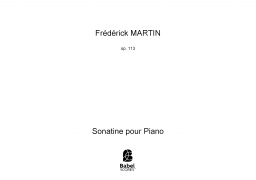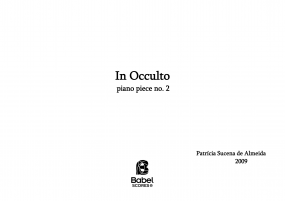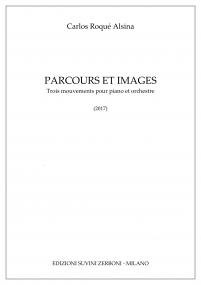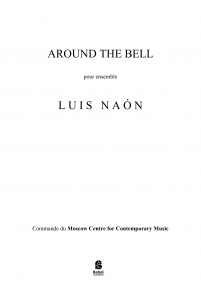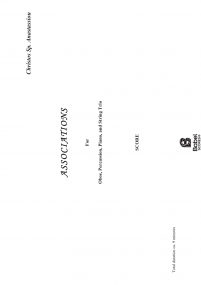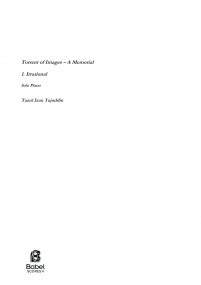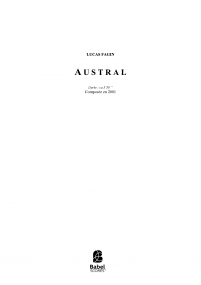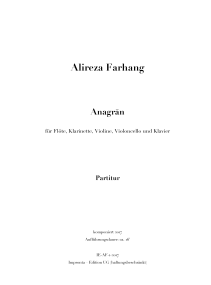Recherche avancée
Lysozyme Synthesis
for piano
7,00 €
Version numérique (+0,00 €) à télécharger
Version papier (+14,80 € impression et livraison ). Colissimo7-14 days aprox.
Chez BabelScores, quand vous achetez une partition, vous pouvez ensuite contacter directement le compositeur ici même !
Caractéristiques
Region
Europe
Estimated Duration
6 - 10min
Date
2003
ISMN : 979-0-2325-4672-8
Vidéos
Notes sur cette pièce
To be considered by the player:
Lysozyme Synthesis doesnʼt intend at all to be an “autopoietic composition”. The fact of having a structure based on the biologic concept of the protein synthesis, it doesnʼt imply that there arenʼt discretionary processes, on the contrary, they exist. The structure of the piece can be comparable to a draw where the main lines are delineated under a scientific base (being mathematic, physic, biologic or of other kind), which is logic and strict, but for example, the type of pencil is a choice made by the author (still strict by certain parameters defined under the referred scientific base or by the author, according to an identical logic, but not a transcription).
All this fundaments, this “almost process of legitimating” of the work is of extreme importance to the interpretation. In Lysozyme Synthesis, the player can (and should) make certain choices. Specifically: along with eventual parameters that can appear into the score as ad libitum, in the bars 57 to 60, the use of pedal una corda is a choice, is ad libitum. This indication doesnʼt appear directly on the score, since it only should happen depending on the piano and room acoustics.
Note: the fact that I am not affirming this piece as an “autopoietic composition”, it doesnʼt imply in any way that the player doesnʼt try to play exactly what is in the score, it only intend a better comprehension of the philosophy related to the construction of the piece, in order to allow and stat clearly that each player can and should have her/his own vision, should establish nuances in the different alterations of the timbre, should be one, singular, basically, should execute the indications of the score trying to be as accurate as possible, using her/his own idiosyncratic complex in a way that she/he believe to be the most proper. Getting back to the metaphor of the draw, the player shouldnʼt create any line, colour or even blow to take out the coal in excess, she/he should show the draw with more or less light, in different perspectives, all in a way that the receiver never loose perception of the original.
Notes for a comprehension of the previous text:
Autopoiesis - the process whereby an organization produces itself. An autopoietic organization is an autonomous and self-maintaining unity which contains component-producing processes. Autopoiesis, a concept coined by Maturana and Varela in their biochemical theory of living organisms and later adopted by Luhmann in his theory of social systems, has become obviously also the key concept of the latter's theory of art as a particular system of communication.
About the piece performance history:
This piece received an honorable mention in the 1st Jorge Peixinho Prize. The president of the jury, pianist Nancy Lee Harper, came personally to tell me she thought the piece was impossible to play. It was premiered by greek engineer, musicologist, conductor, composer and pianist Athanasios Trikoupis in 2005, in Graz, while was invited composer for the Hörfest, organized by Peter Jakober and Erich Ranneger. I was appointed to the festival by composer Georg Friedrich Haas, that I met in 2004 Darmstadt Internationale Ferienkurse für Neue Musik, where I gave a conference entitled “Biological Models Applied to Music Composition”.
The piece was given to several portuguese pianists, but it was only premiered in Portugal by Ana Telles, in November 2011, in a monographic commentated concert organized by Electroacoustic, Music and Sound Courses Alumni Network (EMSCAN) board, namely Rui Borges and Johann Pereira, in a project support by Universidade do Algarve (Portugal) - Centre for Molecular and Structural Biomedicine (CBME) and the Portuguese Ministry of Culture.
Acknowledgement and gratitude to Ana Telles for editorial remarks.
Ajouter à une playlist
- Identifiez-vous pour créer une liste
To be considered by the player:
Lysozyme Synthesis doesnʼt intend at all to be an “autopoietic composition”. The fact of having a structure based on the biologic concept of the protein synthesis, it doesnʼt imply that there arenʼt discretionary processes, on the contrary, they exist. The structure of the piece can be comparable to a draw where the main lines are delineated under a scientific base (being mathematic, physic, biologic or of other kind), which is logic and strict, but for example, the type of pencil is a choice made by the author (still strict by certain parameters defined under the referred scientific base or by the author, according to an identical logic, but not a transcription).
All this fundaments, this “almost process of legitimating” of the work is of extreme importance to the interpretation. In Lysozyme Synthesis, the player can (and should) make certain choices. Specifically: along with eventual parameters that can appear into the score as ad libitum, in the bars 57 to 60, the use of pedal una corda is a choice, is ad libitum. This indication doesnʼt appear directly on the score, since it only should happen depending on the piano and room acoustics.
Note: the fact that I am not affirming this piece as an “autopoietic composition”, it doesnʼt imply in any way that the player doesnʼt try to play exactly what is in the score, it only intend a better comprehension of the philosophy related to the construction of the piece, in order to allow and stat clearly that each player can and should have her/his own vision, should establish nuances in the different alterations of the timbre, should be one, singular, basically, should execute the indications of the score trying to be as accurate as possible, using her/his own idiosyncratic complex in a way that she/he believe to be the most proper. Getting back to the metaphor of the draw, the player shouldnʼt create any line, colour or even blow to take out the coal in excess, she/he should show the draw with more or less light, in different perspectives, all in a way that the receiver never loose perception of the original.
Notes for a comprehension of the previous text:
Autopoiesis - the process whereby an organization produces itself. An autopoietic organization is an autonomous and self-maintaining unity which contains component-producing processes. Autopoiesis, a concept coined by Maturana and Varela in their biochemical theory of living organisms and later adopted by Luhmann in his theory of social systems, has become obviously also the key concept of the latter's theory of art as a particular system of communication.
About the piece performance history:
This piece received an honorable mention in the 1st Jorge Peixinho Prize. The president of the jury, pianist Nancy Lee Harper, came personally to tell me she thought the piece was impossible to play. It was premiered by greek engineer, musicologist, conductor, composer and pianist Athanasios Trikoupis in 2005, in Graz, while was invited composer for the Hörfest, organized by Peter Jakober and Erich Ranneger. I was appointed to the festival by composer Georg Friedrich Haas, that I met in 2004 Darmstadt Internationale Ferienkurse für Neue Musik, where I gave a conference entitled “Biological Models Applied to Music Composition”.
The piece was given to several portuguese pianists, but it was only premiered in Portugal by Ana Telles, in November 2011, in a monographic commentated concert organized by Electroacoustic, Music and Sound Courses Alumni Network (EMSCAN) board, namely Rui Borges and Johann Pereira, in a project support by Universidade do Algarve (Portugal) - Centre for Molecular and Structural Biomedicine (CBME) and the Portuguese Ministry of Culture.
Acknowledgement and gratitude to Ana Telles for editorial remarks.
Instrumentation
Piano
Score Details
Format - A4 / US Letter
Pages - 20
Pages - 20




